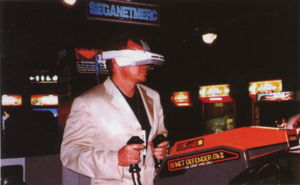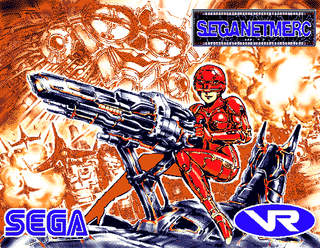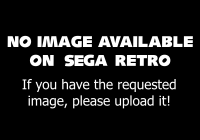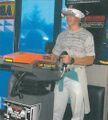Difference between revisions of "Dennou Senki Net Merc"
From Sega Retro
m (→Development) |
m (→Development) |
||
| Line 49: | Line 49: | ||
At the same time, [[Sega]] were reaping the rewards of continued international success in the arcade business thanks to 3D titles such as ''[[Virtua Racing]]'' and popular new amusement facilities in Japan such as [[Roppongi GiGO]], as well as a newfound foothold in the western home console market with the [[Mega Drive]].{{ref|https://web.archive.org/web/20200811132324/https://www.vrfocus.com/2020/07/the-virtual-arena-blast-from-the-past-the-vr-1/}} A company-wide ethos of "High-Tech Interactive Entertainment" was adopted to drive its endeavours forward.{{ref|https://web.archive.org/web/20210509015243/https://twitter.com/ashizuka16bit/status/1390970672063553537}} | At the same time, [[Sega]] were reaping the rewards of continued international success in the arcade business thanks to 3D titles such as ''[[Virtua Racing]]'' and popular new amusement facilities in Japan such as [[Roppongi GiGO]], as well as a newfound foothold in the western home console market with the [[Mega Drive]].{{ref|https://web.archive.org/web/20200811132324/https://www.vrfocus.com/2020/07/the-virtual-arena-blast-from-the-past-the-vr-1/}} A company-wide ethos of "High-Tech Interactive Entertainment" was adopted to drive its endeavours forward.{{ref|https://web.archive.org/web/20210509015243/https://twitter.com/ashizuka16bit/status/1390970672063553537}} | ||
| − | As part of its efforts to stay at the forefront of gaming technology, the company had shown an interest in virtual reality, with [[Sega of America]] becoming the first to unveil the | + | As part of its efforts to stay at the forefront of gaming technology, the company had shown an interest in virtual reality, with [[Sega of America]] becoming the first to unveil the separate [[Sega VR]] project in 1993. During the same year, it was announced that Sega's Japanese arcade development divisions had won a £3.5 million contract{{magref|megapower|1|8}} to collaborate with Virtuality on their own unspecified VR plans.{{ref|https://web.archive.org/web/20200811132324/https://www.vrfocus.com/2020/07/the-virtual-arena-blast-from-the-past-the-vr-1/}}{{magref|sfm|3|7}}{{magref|mega|12|7}} |
Coupled with speculation that the results would appear in its newly-opened amusement facilities in the west, including [[Sega VirtuaLand]] and [[Sega World Bournemouth]], Sega's partnership with Virtuality was widely reported on in the amusement industry, with then-president of Sega [[Hayao Nakayama]] and Virtuality founder Jonathan Waldern pictured on the front of the Japanese ''[[Game Machine]]'' trade paper.{{magref|gamemachinejp|455|1}} | Coupled with speculation that the results would appear in its newly-opened amusement facilities in the west, including [[Sega VirtuaLand]] and [[Sega World Bournemouth]], Sega's partnership with Virtuality was widely reported on in the amusement industry, with then-president of Sega [[Hayao Nakayama]] and Virtuality founder Jonathan Waldern pictured on the front of the Japanese ''[[Game Machine]]'' trade paper.{{magref|gamemachinejp|455|1}} | ||
Revision as of 09:43, 7 July 2021
| Dennou Senki Net Merc | |||||||||
|---|---|---|---|---|---|---|---|---|---|
| System(s): Sega Net Merc, Model 1 | |||||||||
| Publisher: Sega | |||||||||
| Developer: Sega AM3[1], Virtuality | |||||||||
| Genre: Shoot-'em-up | |||||||||
| Number of players: 1 | |||||||||
|
Dennou Senki Net Merc (電脳戦記ネットマーク, Cyber Troopers Network Mercenary) is an arcade game developed by Sega with assistance from Virtuality.[2] It is the only game created for the Sega Net Merc system (a specialized arcade cabinet using two Sega Model 1 boards with the Mega Visor Display to produce virtual reality visuals), so the two are often used interchangeably. If considered to be a Model 1 game, it is the final release for the system.
Contents
Gameplay
Dennou Senki Net Merc is an on-rails shoot-'em-up game, in which players use a large gun controller to fire at enemies. Being a virtual reality game, players are also given a VR headset (a "MVD" or "Mega Visor Display"[3], similar to those found in the VR-1), allowing for their head movements to be tracked in real time and therefore see a full 360 degree view of their surroundings.
The game itself is a straightforward shooter using a first person perspective; no set time limit is provided, however a depletable health bar is used to curb time. Players are always stood facing in one direction behind the gun controller during gameplay. The complex nature of the system means that a member of staff is usually on hand to assist users with the headset. Gameplay is also outputted for onlooking bystanders onto a monitor at the left hand side of the cabinet.
Levels
Dennou Senki Net Merc takes place in four levels; though the start and end stages remain the same on any run, the middle two stages can be selected interchangeably.[4]
| Desert Stage | |
|---|---|
| The game begins with a desert practise level. In it, enemies and obstacles such as combat vehicles, mechs, war bases, and explosible barrels only appear in front of the player. Once it is completed, a choice of two different level routes is given through a warp station; in both of these, the difficulty increases, with enemies now appearing from all sides. | |
| CPU Stage | |
| The upper route given to players after the first level is held inside a large computer. In it, the player is transported into a CPU corrupted by a virus that has manifested itself physically in the form of the stage's enemies. They are tasked with ending the corruption by destroying these, as well as an end of level boss, with vaccines. | |
| City Stage | |
| The lower selectable route once the practise level has been completed transports the player to an urban city landscape in mid-day. Combat vehicles and soldier robots below the player on the city streets can be destroyed, as well as a number of hovering enemies and an end of level mech boss. | |
| Final Stage | |
| Accessed through a ground warp in the previous selected level, the final part of the game takes place in a spherical space station inhabited by numerous larger enemies. If successfully completed, a third person run-through of how each level was played is given to the player before the game concludes. |
History
Development
Though existent as a concept for several decades beforehand and used in a number of non-gaming sectors, the first time virtual reality experienced widespread popularity was the early 1990s, as video games began to be applied to the technology.[5] One of the early beneficiaries of this initial boom in interest was Virtuality, a United Kingdom-based startup whose 1000CS and 1000SD system series garnered worldwide consumer acceptance.[5] Their hardware saw installations in a variety of entertainment venues and amusement arcades from the United States to Japan, however, some criticism was made over the rudimentary technology involved and the imperfect design quality of the head-mounted displays utilised.[5]

At the same time, Sega were reaping the rewards of continued international success in the arcade business thanks to 3D titles such as Virtua Racing and popular new amusement facilities in Japan such as Roppongi GiGO, as well as a newfound foothold in the western home console market with the Mega Drive.[6] A company-wide ethos of "High-Tech Interactive Entertainment" was adopted to drive its endeavours forward.[7]
As part of its efforts to stay at the forefront of gaming technology, the company had shown an interest in virtual reality, with Sega of America becoming the first to unveil the separate Sega VR project in 1993. During the same year, it was announced that Sega's Japanese arcade development divisions had won a £3.5 million contract[8] to collaborate with Virtuality on their own unspecified VR plans.[6][9][10]
Coupled with speculation that the results would appear in its newly-opened amusement facilities in the west, including Sega VirtuaLand and Sega World Bournemouth, Sega's partnership with Virtuality was widely reported on in the amusement industry, with then-president of Sega Hayao Nakayama and Virtuality founder Jonathan Waldern pictured on the front of the Japanese Game Machine trade paper.[2]
Details revealed at the time of the contract signing stated that the partnership would be centred around an intent to produce higher quality VR visuals than the previous widely-known Virtuality systems through the use of Sega's successful Model 1 arcade board, however it was not yet known which specific headset would be used to output these.[11]
Development of what would later become Dennou Senki Net Merc commenced soon after the contract was finalised, with two programmers (Andy Reece and Stephen Northcott, a former programmer at Incentive Software) and two artists from Virtuality living in Tokyo for a year to collaborate with the AM3 division and code the game in Assembler. An integral part of development was perfecting the design of the Mega Visor Display planned to be used in it and AM5's VR-1 theme park attraction - the MVD was an original headset created to outclass previous examples in comfortability, weight, and ergonomics.[12] The project was planned to be completed and released in 1994, though only the aforementioned VR-1 saw completion during that year.[6]
Release
Shortly after the launch of VR-1 in July 1994 at Yokohama Joypolis, Dennou Senki Net Merc first appeared in public at the Amusement Machine Show 1994 the following month under its original name, TecWar.[13] Schedule slippages and the cancellation of all Model 1 development efforts except TecWar and the Model 2-reallocated Sega Rally Championship meant that it had not yet been officially released to arcades, and legal conflict subsequently occurred with the advent of William Shatner's similarly-titled TekWar novels and later video game.[14] As a result, a name change to Dennou Senki Net Merc and the coining of the Sega Net Merc system term occurred in the midst of further development.

Eventually, the game reappeared at AOU Show 1995, now using a redesigned Sega Net Merc system cabinet alongside its new name.[15] VR-1, the first release to use the Mega Visor Display, had been received favourably, but by the time of 1995, further emphasis had been put on texture-mapped polygons for graphical quality. These were notably seen at the show in the new Model 2-powered Sega Rally Championship, which received a much more positive reaction;[15] players of Net Merc were reportedly unimpressed with the flat-shaded polygons of the now-outdated Model 1, as well as the gameplay.[14]
Despite its negative reception at the AOU Show expositions, Dennou Senki Net Merc was ultimately kept on Sega's release schedules. It is suggested this was due to a successful location test at the company's large Ikebukuro GiGO amusement facility in the first half of the year, where the game reportedly outperformed Daytona USA on its original trial weekend of operations.[14] However, a shortage of remaining Model 1 hardware said to have affected other later releases meant very few units could be made and sold to arcades - retrospective estimates of total Net Merc machines manufactured range from 20[16] to 70.[14]
Locations where Dennou Senki Net Merc appeared have included a number of Sega-owned facilities in Japan, including Osaka ATC Galbo.[17] Very few units are thought to have been exported outside of the country, however it is known to have been installed in Metropolis,[18] SegaWorld London,[19] and Sega Park Madrid;[20] others were supposedly planned to appear in Sega World Bournemouth and Sega VirtuaLand.[8] Net Merc units were also found in Korea[21] and New Zealand.[22][3] Most installations likely were removed by the early 2000s, and no further games are officially known to have been developed for the Net Merc system after the release of Dennou Senki Net Merc.
Legacy
Despite using the critically-acclaimed Mega Visor Display headset, Dennou Senki Net Merc is retrospectively not considered to have been as influential as Virtuality's other works, both with Sega and without, remaining an obscure distraction as a result of its low production run and resultant lack of popularity. Design motifs associated with it and the MVD would eventually live on in the AM3-developed Cyber Troopers Virtual-On, in which the headset was incorporated into the Virtuaroid mechs.[12] Rumours also circulate which suggest that Cyber Troopers was originally intended to be a release for the Net Merc system.[23]
Archival status
As a result of its low production run and poor reception, very few boards for Dennou Senki Net Merc are known to currently exist. It is suggested only two remain with incomplete Sega Net Merc systems; one is held by arcade collector ShouTime,[24][25] while another was acquired and recorded for the "SEGA MODEL KING" YouTube channel, making it the first known footage of the game recorded off of original Model 1 hardware.[26]
Dennou Senki Net Merc was dumped by ShouTime during the 2010s, however it remains the only Model 1 game to have compatibility and playability issues when ran in MAME due to its virtual reality visuals and hardware discrepancies. A workaround can be reportedly attempted by reconfiguring the game's dip switches, though if not done properly causes graphical issues with the in-game gun model and is not possible with older versions of the emulator.[26]
Videos
Video excerpt showing Dennou Senki Net Merc running (filmed on the Flight Deck[27][28] floor, of Sega World London), taken from episode #7 ("A Special Place") of the third season (1997) of BBC's documentary television series Connections
Gallery
Korean installation, unknown location, circa 2003[21]
Kijima Kogen Park, circa late 1990s[29]
Osaka ATC Galbo, circa 1998
Magazine articles
- Main article: Dennou Senki Net Merc/Magazine articles.
Promotional material
External links
References
- ↑ 1.0 1.1 Sega Arcade History, Enterbrain, page 136
- ↑ 2.0 2.1 Game Machine, "1993-08-15" (JP; 1993-08-15), page 1
- ↑ 3.0 3.1 File:Becoming Virtual - Bodies, Technologies, Worlds (Thesis by Nicola Green, University of Canterbury, New Zealand, 1999).pdf, page 183
- ↑ Saturn Fan, "1995 August" (JP; 1995-07-07), page 94
- ↑ 5.0 5.1 5.2 https://www.newscientist.com/article/mg21829226-000-virtual-reality-meet-founding-father-jaron-lanier/ (Wayback Machine: 2021-04-27 07:39)
- ↑ 6.0 6.1 6.2 https://www.vrfocus.com/2020/07/the-virtual-arena-blast-from-the-past-the-vr-1/ (Wayback Machine: 2020-08-11 13:23)
- ↑ @ashizuka16bit on Twitter (Wayback Machine: 2021-05-09 01:52)
- ↑ 8.0 8.1 Mega Power, "August 1993" (UK; 1993-07-29), page 8
- ↑ Sega Force Mega, "October 1993" (UK; 1993-08-19), page 7
- ↑ Mega, "September 1993" (UK; 1993-08-19), page 7
- ↑ Game Machine, "1993-08-15" (JP; 1993-08-15), page 14
- ↑ 12.0 12.1 https://www.gamebusiness.jp/article/2016/09/14/12597.html (Wayback Machine: 2016-10-04 20:00)
- ↑ Edge, "December 1994" (UK; 1994-10-27), page 12
- ↑ 14.0 14.1 14.2 14.3 http://www.system16.com/hardware.php?id=712 (Wayback Machine: 2021-06-07 08:32)
- ↑ 15.0 15.1 Edge, "May 1995" (UK; 1995-03-20), page 17
- ↑ https://www.bluegartr.com/threads/119249-Sega-NetMerc (Wayback Machine: 2021-07-05 20:58)
- ↑ https://netanker.hatenablog.jp/entry/19980529/p3 (Wayback Machine: 2021-04-10 01:43)
- ↑ Computer & Video Games, "November 1995" (UK; 1995-10-13), page 75
- ↑ File:Escape SegaWorldLondon Incomplete.mp4
- ↑ File:UltimaGeneracion ES 09.pdf, page 33
- ↑ 21.0 21.1 @from2001vr on Twitter (Wayback Machine: 2021-06-17 01:41)
- ↑ File:Becoming Virtual - Bodies, Technologies, Worlds (Thesis by Nicola Green, University of Canterbury, New Zealand, 1999).pdf, page 75
- ↑ @ohfivepro on Twitter (Wayback Machine: 2021-01-12 21:03)
- ↑ https://www.nintendolife.com/news/2016/06/ninterview_preserving_gaming_history_with_arcade_collector_shoutime (Wayback Machine: 2021-01-17 10:22)
- ↑ https://forums.arcade-museum.com/threads/sega-netmerc.295556/ (Wayback Machine: 2021-07-05 20:48)
- ↑ 26.0 26.1 https://www.youtube.com/watch?v=E3Cg40ZmWpQ
- ↑ http://tedsegablog.blogspot.com/2017/06/the-rise-and-fall-of-london-trocadero.html
- ↑ https://3.bp.blogspot.com/-IQO53Njw_qI/WdjMwqRsJWI/AAAAAAAAAaI/TaH5RcMm7c4wOFWYltpE-e7rAV380BPRwCLcBGAs/s1600/trocclosed6.jpg
- ↑ @mukasiya_game on Twitter (Wayback Machine: 2021-03-11 15:40)
| Mega Visor Display | |
|---|---|
| Hardware | Mega Visor Display | VR-1 | Sega Net Merc |
| Software | Space Mission | Planet Adventure | Dennou Senki Net Merc |










